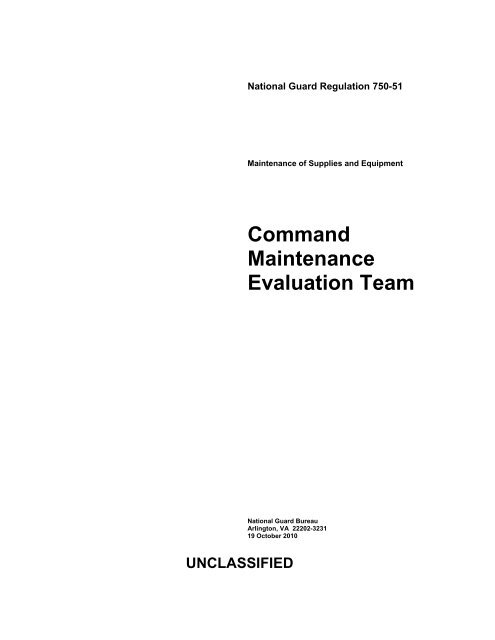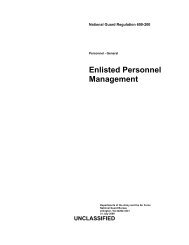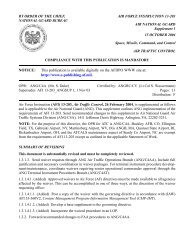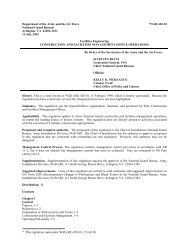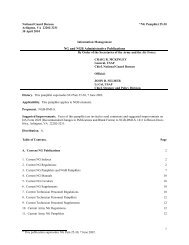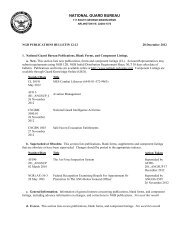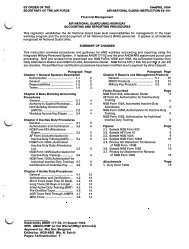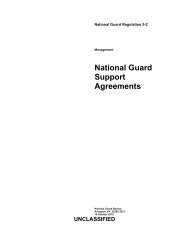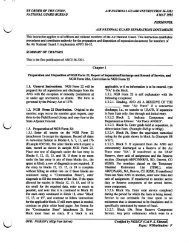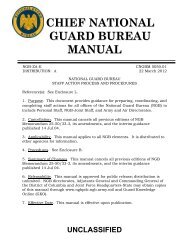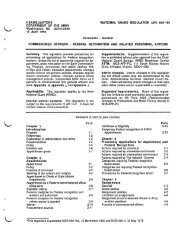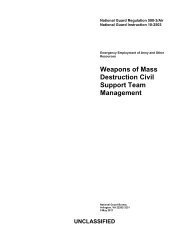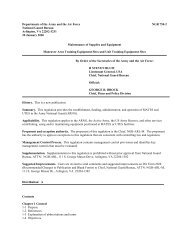Command Maintenance Evaluation Team - National Guard Bureau ...
Command Maintenance Evaluation Team - National Guard Bureau ...
Command Maintenance Evaluation Team - National Guard Bureau ...
Create successful ePaper yourself
Turn your PDF publications into a flip-book with our unique Google optimized e-Paper software.
<strong>National</strong> <strong>Guard</strong> Regulation 750-51<br />
<strong>Maintenance</strong> of Supplies and Equipment<br />
<strong>Command</strong><br />
<strong>Maintenance</strong><br />
<strong>Evaluation</strong> <strong>Team</strong><br />
<strong>National</strong> <strong>Guard</strong> <strong>Bureau</strong><br />
Arlington, VA 22202-3231<br />
19 October 2010<br />
UNCLASSIFIED
SUMMARY of CHANGE<br />
NGR 750-51<br />
<strong>Command</strong> <strong>Maintenance</strong> <strong>Evaluation</strong> <strong>Team</strong><br />
This administrative action revision is dated 19 October 2010.<br />
o The Joint Force Headquarters (JFHQ) Deputy Chief of Staff (DCS) G-4 will<br />
exercise staff supervision over the States COMET program.<br />
o State Surface <strong>Maintenance</strong> Manager (SMM) Facilitates review of the<br />
evaluation schedule with the G3/DCS Operations (DCSOPS) and the <strong>Evaluation</strong><br />
<strong>Team</strong> Chief to prevent conflicts with training events of units to be evaluated.<br />
o <strong>Command</strong>ers of the evaluated unit will submit the required formal response<br />
for an unsatisfactory rating within 30 days to the SMM IAW paragraph 2-2.h.<br />
o <strong>Evaluation</strong> <strong>Team</strong> Chief will maintain the COMET master evaluation schedule,<br />
and review it with G3/DCSOPS to prevent conflicts with training events of<br />
units to be evaluated. Maintain a DA Form 5480 (<strong>Maintenance</strong> Request and<br />
Assignment Register) to record all time expended by team members, including<br />
hours for responding to telephone requests, will be shown on the register.<br />
This data will be used to support requests for additional TDA spaces or to<br />
defend existing COMET team manning levels.<br />
o <strong>Evaluation</strong> cycle changed to 24 months. With a minimum of 24 and a maximum<br />
of 30 months between evaluations.<br />
o A State must evaluate a minimum of 90% and a maximum of 100% of all<br />
eligible units in a 24 month period.<br />
o Defines eligibility criteria for units.<br />
o Updates <strong>Evaluation</strong> Checklist.<br />
o State performance criteria; Green: 4 reports and greater than 90%<br />
evaluated in previous 24 months.<br />
o Amber: four reports and between 80-89% evaluated in previous 24 months.<br />
o Red: Three or less reports and less than 79% evaluated in previous 24<br />
months.<br />
o To receive an overall satisfactory rating, a unit must pass <strong>Maintenance</strong><br />
Management, AMSS Data Management, and Primary Weapons Systems Equipment. If a<br />
unit is satisfactory in all must pass areas, and <strong>Maintenance</strong> Sustainability or<br />
Material General, it is satisfactory overall.<br />
o Alerted for Mobilization: Units will not be evaluated within six months<br />
of Mobilization Station Date (MOBSAD) date.<br />
o Demobilized: Unit evaluation after demobilization will occur no earlier<br />
than six months after Release from Active duty (REFRAD) date.<br />
o Activated (new unit or UIC): <strong>Evaluation</strong> will occur no earlier than 12 or<br />
later than 24 months after activation. The States MAIT team should visit the<br />
unit prior to their first COMET evaluation.<br />
o Deactivated: Unit removed from force structure. Upon receipt of<br />
deactivation order, from either NGB or Department of Defense, unit is no<br />
longer eligible for evaluation.
o State summary reports are due to NGB twice a year, on the fifteenth day of<br />
April and October of each year. File reports electronically by email on NGB<br />
Form 811 COMET Summary Report to ARNG-ILL-M Maint Reports@ngb.army.mil.<br />
o The State will maintain copies of Form 811 COMET Summary evaluation<br />
reports sent to NGB, unit evaluations, and any re-evaluations for the previous<br />
four years.<br />
o Units will maintain copies of evaluation reports, and any re-evaluations<br />
for the previous four years.<br />
o CL IX program no longer evaluated.<br />
o NGB COMET Summary Report format changed.<br />
o Written instructions on how to complete report.
<strong>National</strong> <strong>Guard</strong> <strong>Bureau</strong> *NGR 750-51<br />
Arlington, VA 22204-1382<br />
19 October 2010<br />
<strong>Maintenance</strong> of Supplies and Equipment<br />
<strong>Command</strong> <strong>Maintenance</strong> <strong>Evaluation</strong> <strong>Team</strong><br />
*This regulation supersedes NGR 750-51, dated 15 August 2003.<br />
By Order of the Secretaries of the Army and the Air Force:<br />
CRAIG R. McKINLEY<br />
USAF<br />
Chief, <strong>National</strong> <strong>Guard</strong> <strong>Bureau</strong><br />
Official:<br />
LtCol, JOHN D. SELMER<br />
Chief, Strategy Policy Division<br />
History. This regulation supersedes NGR 750-51, dated 15 August 2003.<br />
Summary. This regulation on the NGB <strong>Command</strong> <strong>Maintenance</strong> <strong>Evaluation</strong> <strong>Team</strong> (COMET) has been revised to<br />
update the policy on conduct of evaluations, unit eligibility, program conditions and standards. This program will be<br />
implemented at the State and U.S. Territory level. For purposes of this regulation, State will also refer to Territory.<br />
Applicability. This regulation applies to all Army <strong>National</strong> <strong>Guard</strong> units. This regulation does not apply to federally<br />
mobilized ARNG units.<br />
Proponent and Exception Authority. The proponent of this regulation is the Chief, ARNG-ILZ ILL. The<br />
proponent has the authority to approve exceptions or waivers to this regulation that are consistent with controlling<br />
law and regulations. The proponent may delegate this approval authority in writing, to a division chief with the<br />
proponent agency or its direct reporting unit or field operating agency, in the grade of Colonel or equivalent. States<br />
may request a waiver to this regulation by providing justification that includes a full analysis of the expected<br />
benefits, and must include formal review by the States senior legal officer. All waiver requests will be endorsed by<br />
the Adjutant General or senior leader of the requesting State and forwarded through higher headquarters to the<br />
policy proponent.<br />
Management Control Process. This regulation is subject to the requirements of AR 11-2. It contains internal<br />
control provisions and a sample of a checklist for conducting internal control reviews. All States must ensure that<br />
they establish an effective Internal Control Program.<br />
Supplementation. States may add to, but not subtract from, the areas of evaluation identified in this regulation.<br />
Prior approval must be coordinated with ARNG-ILZ ILL-M. <strong>Evaluation</strong> area (scoring) established herein will be<br />
followed to determine satisfactory or unsatisfactory performance.<br />
Suggested Improvements. Users should submit comments and suggested improvements on DA Form 2028<br />
(Recommended Changes to Publications and Blank Forms) to Army <strong>National</strong> <strong>Guard</strong> Readiness Center, ATTN: -<br />
ARNG-ILZ ILL-M, 111 South George Mason Drive, Arlington, VA 22204-1382.<br />
Distribution: A<br />
i
*NGR 750-51 19 October 2010<br />
Contents<br />
Chapter 1<br />
General<br />
Section 1<br />
1-1. Purpose<br />
1-2. References<br />
1-3. Explanation of Abbreviations and Terms<br />
1-4. Responsibilities<br />
The Chief of <strong>National</strong> <strong>Guard</strong> <strong>Bureau</strong><br />
The Joint Forces Headquarters Deputy Chief of Staff (DCS) G-4<br />
The State Surface <strong>Maintenance</strong> Manager (SMM)<br />
The Unit <strong>Command</strong>er<br />
The <strong>Evaluation</strong> <strong>Team</strong> Chief<br />
Section II<br />
1-5. Objectives<br />
Chapter 2<br />
Policies and Procedures<br />
2-1. General<br />
2-2. Policy<br />
2-3. Procedures<br />
2-4. <strong>Evaluation</strong> standards<br />
2-5. Exemptions<br />
2-6. COMET <strong>Evaluation</strong> <strong>Team</strong> composition<br />
2-7. Technical assistance<br />
Chapter 3<br />
Reports<br />
3-1. NGB Summary Report<br />
3-2. <strong>Evaluation</strong> Report<br />
Appendixes<br />
A. References<br />
B. NGB COMET Summary Report format<br />
C. COMET procedures<br />
D. Sample <strong>Evaluation</strong> Checklist<br />
Figure List<br />
Figure B-1: NGB COMET Summary Report format<br />
Glossary<br />
ii
19 October 2010 *NGR 750-51<br />
Chapter 1<br />
General<br />
Section I<br />
1-1. Purpose<br />
This regulation establishes the responsibilities, scope, policies, procedures, and checklists for the <strong>Command</strong><br />
<strong>Maintenance</strong> <strong>Evaluation</strong> <strong>Team</strong> (COMET) program. It does not prohibit or replace the formal or informal evaluation<br />
of maintenance programs conducted at the discretion of commanders at any level. This regulation will be used in<br />
conjunction with other regulations and publications to form a solid maintenance program and oversight of Modified<br />
Table of Organization (MTOE) and Table of Distribution and Allowances (TDA) units. This includes AR 750-1 as<br />
applicable to NGB units.<br />
1-2. References<br />
Related publications are listed in Appendix A. Prescribed and referenced forms are also listed in Appendix A.<br />
1-3. Explanation of Abbreviations and Terms<br />
Abbreviations used in this regulation are explained in the Glossary.<br />
1-4. Responsibilities<br />
a. Director of the Army <strong>National</strong> <strong>Guard</strong> (DARNG) will:<br />
(1) Prescribe criteria, responsibility, objectives, and procedures for conduct of <strong>Command</strong> <strong>Maintenance</strong><br />
<strong>Evaluation</strong> <strong>Team</strong> (COMET) program.<br />
(2) Allocate Federal funds to states for manning of COMET evaluation teams.<br />
(3) Designate a representative to administer the program on behalf of NGB.<br />
b. Chief Army <strong>National</strong> <strong>Guard</strong> Logistics Division <strong>Maintenance</strong> Branch (ARNG-ILZ ILL-M) will:<br />
(1) Administer the NGB COMET program.<br />
(2) Submit to the DARNG a report on the NGB COMET program for the previous fiscal year. Provides<br />
an assessment of State COMET programs and any trends that impact equipment readiness and the Army <strong>National</strong><br />
<strong>Guard</strong>.<br />
c. State Adjutants General will:<br />
(1) Create a COMET program at the State level.<br />
(2) Exercise operational control of COMET evaluations.<br />
(3) Provide personnel and equipment necessary to fully execute the COMET program including, but not<br />
limited to, TDY, and per diem.<br />
(4) Designate a representative to administer the program on their behalf.<br />
(5) Establish specific maintenance goals and performance measurements based on objectives in paragraph<br />
1-5 of this regulation.<br />
d. The Joint Force Headquarters (JFHQ) Deputy Chief of Staff (DCS) G-4 will exercise staff supervision over<br />
the States COMET program. To carry out this responsibility the DCS G-4 will:<br />
(1) Plan, program and budget for the state NGB COMET program.<br />
(2) Periodically evaluate program performance.<br />
(3) Establish specific materiel and maintenance goals and performance measures based on objectives in<br />
paragraph 1-5 of this regulation.<br />
e. State Surface <strong>Maintenance</strong> Managers (SMMs') will:<br />
(1) Administer the State COMET program on behalf of the Deputy Chief of Staff (DCS) G4.<br />
(2) Ensure the State COMET program complies with all regulatory requirements.<br />
(3) Coordinate Development of a COMET master evaluation schedule of all eligible units in the State.<br />
(4) Facilitate review of the evaluation schedule with the G3/DCS Operations (DCSOPS) and the<br />
<strong>Evaluation</strong> <strong>Team</strong> Chief to prevent conflicts with training events of units to be evaluated.<br />
(5) Provide personnel to accomplish COMET evaluations and when feasible, utilize Table of Distribution<br />
and Allowances assets to assist in the accomplishment of COMET evaluations.<br />
(6) Ensure unit notification lead time meets the programs intent.<br />
(7) Briefs the DCS G-4 annually on evaluation results for the previous year.<br />
(a) Identifies significant problems or trends in units, and corrective actions.<br />
(b) Provides an assessment of conduct and supervision of PMCS throughout the State.<br />
1
*NGR 750-51 19 October 2010<br />
(c) Briefs the number of scheduled unit evaluations not completed, reasons why, and suggestions for<br />
improving the COMET program.<br />
f. <strong>Command</strong>ers of the units being evaluated will:<br />
(1) Ensure that unit and detachment personnel, equipment, and records are available during the evaluation.<br />
(2) Attend the in-brief and out-brief.<br />
(3) Establish policies and procedures to correct faults and prevent them from reoccurring.<br />
(4) Identify faults that require maintenance activities or higher headquarters support to correct.<br />
(5) Submit the required formal response for an unsatisfactory rating within 30 days to the SMM IAW<br />
paragraph 2-2(h), below.<br />
(6) Request MAIT team support through command channels to the SMM no later than 30 days after the<br />
evaluation.<br />
g. <strong>Evaluation</strong> <strong>Team</strong> Chief will:<br />
(1) Maintain the COMET master evaluation schedule, and review it with G3/DCSOPS to prevent conflicts<br />
with training events of units to be evaluated.<br />
(2) Notify units of their pending evaluation.<br />
(3) Functions as the Point of Contact between the evaluation team and the unit being evaluated.<br />
(4) Ensure team members have the technical expertise or experience with equipment of the units being<br />
evaluated.<br />
(5) When necessary, temporarily adds team members for visits to units with special equipment (medical,<br />
signal, missile, CBRNE).<br />
(6) Ensure that all evaluations are conducted in a standardized manner with an in brief, evaluation period,<br />
and out brief.<br />
(7) Submit evaluation results to the SMM, and report to NGB semi-annually using NGB Form 811<br />
COMET Summary Report.<br />
(8) Maintain a DA Form 5480 (<strong>Maintenance</strong> Request and Assignment Register) to record all time<br />
expended by team members, including hours for responding to telephone requests on the register. This data confirms<br />
if existing COMET team manning levels are adequate or additional personnel are needed. The SMM and <strong>Evaluation</strong><br />
<strong>Team</strong> Chief review the 5480 during October of each fiscal year. They notify the DCS G4 if additional personnel or<br />
resources are needed.<br />
(9) Coordinate re-inspections.<br />
Section II<br />
1-5. Objectives<br />
a. The COMET programs intent is to provide State Adjutants General and commanders at all levels the<br />
following information.<br />
b. Appraise the level and quality of unit maintenance management and the current readiness status of Army<br />
<strong>National</strong> <strong>Guard</strong> units or organizations.<br />
c. Assess supply operations that relate to maintenance; i.e. repair parts, tools, Basic Issue Items (BII),<br />
publications, and training.<br />
d. Measure driver/crew proficiency in maintenance and operator-level Preventative <strong>Maintenance</strong> Checks and<br />
Services (PMCS).<br />
e. Evaluate the commander’s use of M-Day resources to maintain equipment readiness within the unit.<br />
f. Assess the combat readiness and sustainability of equipment.<br />
g. Identify systemic issues within the State affecting maintenance operations and equipment readiness that<br />
require additional effort and/or assistance.<br />
h. Indicate if actions taken to fix faults found during prior COMET, Inspector General (IG), <strong>Command</strong><br />
Logistics Review <strong>Team</strong>, Expanded (CLRTX), Army Audit Agency (AAA), and General Accounting Office (GAO)<br />
visits were effective.<br />
Chapter 2<br />
Policies and Procedures<br />
2-1. General<br />
The COMET program is a command evaluation tool that must be used in conjunction with other command<br />
evaluations, both formal and informal, to evaluate the effectiveness of unit level maintenance operations and the<br />
2
19 October 2010 *NGR 750-51<br />
combat readiness of all categories of surface maintenance. The COMET will strive to evaluate unit maintenance<br />
programs as they are conducted on a day-to-day basis. The COMET will place emphasis on identifying those areas<br />
requiring attention by the commander and the resolution of systemic problems. Although detailed evaluation of<br />
materiel is a function of the COMET program, evaluations will be oriented to combat readiness and sustainability.<br />
The evaluations are conducted during Inactive Duty Training assemblies (IDT) to maximize mentorship of the M-<br />
Day soldier and their conduct of unit maintenance activities. On the spot training and assistance is encouraged. The<br />
overriding principle of COMET evaluations is the individual and units ability to maintain their equipment in any<br />
environment. "Can the operator maintain the equipment while performing Federal or State missions for sustained<br />
periods of time?”<br />
2-2. Policies<br />
a. ARNG units will receive a COMET visit at a minimum of 24, maximum of 30 month intervals. <strong>Evaluation</strong>s<br />
will be conducted at a separate detachment, company, troop, and battery level as appropriate. The COMET may be<br />
incorporated into the command evaluation program if all areas listed in this publication are evaluated. All COMET<br />
related data will be consolidated and recorded on NGB Form 811 COMET Summary Report and submitted semiannually<br />
to ARNG-ILZ ILL-M on the 15 th of April and October respectively.<br />
b. States are evaluated by NGB on management of their program, and execution of their COMET Master<br />
Schedule to evaluate units.<br />
c. Task: Perform a COMET evaluation on all eligible units stationed in the state.<br />
d. Conditions: Each state is required to evaluate all eligible units once every 24 months. There must be a<br />
minimum of 24 and a maximum of 30 months between evaluations. Completed evaluations should not exceed<br />
100% within a 24 month period.<br />
e. Standard: Schedule and evaluate 90% or above of all eligible Army <strong>National</strong> <strong>Guard</strong> units stationed within<br />
the state in a 24 month period.<br />
f. All units are given advanced notification of an evaluation. The intent of the advanced notification is to<br />
provide for proper protocol, of a scheduled evaluation. Prior coordination with training personnel (i.e. DCSOPS) is<br />
essential to ensure unit personnel, equipment, and records are available on the date of the evaluation.<br />
(1) Detachments are evaluated as part of the parent unit.<br />
(2) If the parent unit is in another State, the detachment is evaluated and counted as a separate unit.<br />
g. A COMET evaluation will not be suspended or converted to an assistance visit to avoid an unsatisfactory<br />
assessment. Units will correct faults in all areas rated unsatisfactory, prior to re-evaluation.<br />
h. Unsatisfactory rating:<br />
(1) State Adjutant General’s will ensure that unit commanders will develop written corrective action plans<br />
no later than 30 days after the evaluation. This response should include corrective actions taken for faults identified<br />
during the evaluation and action plans to prevent them from reoccurring.<br />
(2) The <strong>Evaluation</strong> <strong>Team</strong> Chief will advise the inspected unit command representative on assistance<br />
available from a <strong>Maintenance</strong> Assistance and Instruction <strong>Team</strong> (MAIT). If a visit is required, the unit must request<br />
support through command channels to the SMM no later than 30 days after the evaluation.<br />
(3) Units rated unsatisfactory will be monitored by their “in State” higher headquarters which must<br />
schedule a re-evaluation within 180 days after the initial evaluation. The unit’s higher headquarters will monitor the<br />
unit’s correction of faults and will coordinate a re-evaluation with the SMM.<br />
(4) Unsatisfactory areas will be re-evaluated within 180 days. The SMM designates who will do the reevaluation<br />
and the results incorporated into the next report to state headquarters and NGB.<br />
(5) States will retain records of all evaluations for four years.<br />
i. The States will report evaluation results on NGB Form 811 as outlined in Appendix B, and email to:<br />
ARNG-ILL-M Maint Reports@ngb.army.mil or by postal delivery to the Director, Army <strong>National</strong> <strong>Guard</strong>,<br />
ATTN: ARNG-ILZ ILL-M, 111 South George Mason Drive, Arlington, VA 22204-1382. This report will be<br />
submitted not later than the fifteenth of April for the first period, which is October to March, and the fifteenth of<br />
October for the second period, which is April to September.<br />
2-3. Procedures<br />
States will develop the specific procedures, in accordance with guidance provided in this regulation, for the<br />
following areas:<br />
a. <strong>Evaluation</strong> procedures; see Appendix C of this regulation.<br />
b. Detailed checklist for evaluations. Appendix D contains a sample checklist.<br />
c. <strong>Evaluation</strong> forms.<br />
3
*NGR 750-51 19 October 2010<br />
4<br />
d. Notification procedures.<br />
e. Materials to be made available to the COMET team by the unit and/or unit preparation.<br />
f. Requirements for entrance and exit briefings.<br />
g. Re-evaluations<br />
2-4. <strong>Evaluation</strong> Standards<br />
Units will be evaluated in the following areas:<br />
a. <strong>Maintenance</strong> Management. As a minimum, those areas of maintenance management identified in Appendix<br />
C, paragraph C-3 will be evaluated. To receive an overall satisfactory rating in this area, units must achieve a GO in<br />
80 percent of the areas evaluated.<br />
b. Army Material Status System (AMSS) Data Management. As a minimum, those items identified in<br />
Appendix C, paragraph C-4 will be evaluated. To receive an overall satisfactory rating in this area, 90% of all<br />
AMSS reportable LINs' reviewed must have all data elements correct.<br />
c. <strong>Maintenance</strong> Sustainability. As a minimum, those items identified in Appendix C, paragraph C-5 will be<br />
evaluated. To receive an overall satisfactory rating in this area, units must achieve a GO in 80 percent of the areas.<br />
d. All reportable Primary Weapons Systems and Equipment (PWSE) reportable items as identified in AR 700-<br />
138, Appendix B and AR 220-1, Appendix C. These are critical to accomplish primary mission support tasks. This<br />
equipment is required to refuel, rearm, power, move, or provide direct command and control. To receive an overall<br />
satisfactory rating in this area, units must achieve a GO on 90 percent of the equipment inspected that is identified as<br />
PWSE. Units with nine or less PWSE items available to inspect will be considered to meet the 90 percent standard if<br />
only one item is NOGO.<br />
e. Materiel General. Materiel General is Equipment Readiness Code (ERC) B, and those ERC A items not<br />
listed in AR 700-138, Appendix C. Those items identified in C-7 of this publication will be evaluated. To receive a<br />
satisfactory rating in this area, units must achieve an average 90 percent GO rating for equipment inspected that is<br />
identified as Materiel General.<br />
f. A simple scoring system is recommended for a unit’s overall rating of satisfactory or unsatisfactory. Do<br />
not change your scoring system in the middle of a fiscal year.<br />
g. Overall Unit Rating. To receive an overall satisfactory rating, a unit must pass four out of the five areas<br />
listed above. A unit “must pass” <strong>Maintenance</strong> Management, AMSS Data Management, and Primary Weapons<br />
Systems Equipment. If a unit is satisfactory in all three “must pass” areas, and <strong>Maintenance</strong> Sustainability or<br />
Material General, it is “satisfactory overall”<br />
2-5. Exemptions<br />
a. Units; see table 2-5 this paragraph.<br />
(1) Alerted for Mobilization: Units will not be evaluated within six months of Mobilization Station Date<br />
(MOBSAD) date.<br />
(2) Demobilized: Unit evaluation after demobilization will occur no earlier than six months after Release<br />
from Active duty (REFRAD) date.<br />
(3) Activated (new unit or UIC): <strong>Evaluation</strong> will occur no earlier than 12 or later than 24 months after<br />
activation. The States MAIT team should visit the unit prior to their first COMET evaluation.<br />
(4) Deactivated: Unit removed from force structure. Upon receipt of deactivation order, from either the<br />
NGB or the Department of Defense, the unit is no longer eligible for evaluation.<br />
Table 2-5 Exemption criteria<br />
Criteria Scenario Exemption Next action<br />
Alerted / Mobilized MOBSAD 6 months Prior Per COMET<br />
schedule<br />
Demobilized REFRAD 6 months after Per COMET<br />
schedule<br />
Unit activation New / changed UIC 12 months after effective date Per COMET<br />
schedule<br />
Unit deactivation Removed from force Upon notification from DA or NGB Remove from<br />
schedule<br />
b. The following categories of materiel should not be subject to evaluation by the COMET
19 October 2010 *NGR 750-51<br />
(1) Equipment and supplies in USP&FO stock accounts that are identified by NGB as excess to the Army<br />
or unserviceable waiting turn in.<br />
(2) Equipment listed specifically in designated DA publications as training aids for classroom instructional<br />
purposes.<br />
(3) Fixed plant or installed property accounted for in accordance with AR 420-18, including structures and<br />
facilities.<br />
(4) Supplies and equipment in depot pack with the formal authorization of the USP&FO.<br />
(5) Transportation Motor Pool (TMP) vehicles if designated non-tactical vehicles not permanently handreceipted<br />
to units or activities.<br />
2-6. <strong>Evaluation</strong> <strong>Team</strong> Composition<br />
a. The <strong>Evaluation</strong> <strong>Team</strong> Chief will be a commissioned officer, warrant or senior non-commissioned officer.<br />
b. <strong>Team</strong> members must be fully qualified in the commodity areas they will evaluate. Their evaluation must be<br />
professional, impartial, and instructional to the unit being evaluated.<br />
c. All personnel require security clearances to evaluate sensitive equipment and documents.<br />
d. <strong>Team</strong> member expertise should enable evaluation of the unit, quantity and types of equipment, within the<br />
time allocated for the evaluation. Maximum use of cross-trained evaluators will minimize personnel requirements<br />
and reduce the impact on the unit being evaluated. Evaluators required for specialized equipment should be<br />
requested from support maintenance facilities.<br />
e. MAIT personnel will not participate in COMET evaluations, command evaluations, annual general<br />
evaluations, annual training evaluations, spot checks, roadside evaluations; command logistics review teams, or any<br />
other command evaluation program IAW AR 750-1.<br />
2-7. Technical Assistance<br />
<strong>Command</strong>ers should request MAIT team visits to occur semi annually as part of their maintenance management<br />
program. The MAIT is specifically designed to provide this type of assistance to the units in a confidential manner.<br />
MAIT visits are a commander’s best external resource for maintenance assistance. The MTOE Field <strong>Maintenance</strong><br />
units, Combined Support <strong>Maintenance</strong> Shops (CSMS), Unit Training Equipment Sites (UTES), Maneuver Area<br />
Training Equipment Sites (MATES) and Field <strong>Maintenance</strong> Shops (FMS) can provide technical training assistance<br />
and instructions, follow-up action on repair parts and general advice on maintenance and supply procedures.<br />
Chapter 3<br />
Reports<br />
3-1. NGB Report<br />
a. State summary reports are due to NGB twice a year, on the fifteenth day of April and October of each<br />
year. File reports electronically using NGB Form 811 COMET Summary Report and email to ARNG-ILL-M<br />
Maint Reports@ngb.army.mil. Electronic copies of the report format are available from the ARNG-ILL-M<br />
COMET program Staff Action Officer upon request. ARNG will maintain electronic copies per Army Records<br />
Information Management System (ARIMS). States will maintain summary reports for the previous four years.<br />
b. ARNG evaluation of state COMET program performance focuses on the percentage of eligible unit<br />
evaluations conducted in a twenty four (24) period. ARNG performance criteria are as follows:<br />
(1) GREEN: >=90% of eligible units evaluated and four reports submitted.<br />
(2) AMBER: 79-89% of eligible units evaluated and three or more reports submitted.<br />
(3) RED:
*NGR 750-51 19 October 2010<br />
Appendix A<br />
References<br />
Section I<br />
Required Publications<br />
AR 200-1<br />
Environmental Protection and Enhancement (Cited in Table D-1)<br />
AR 220-1<br />
Unit Status Reporting (Cited in Para 1-10 e, C-7)<br />
AR 385-10<br />
Army Safety Program (Cited in Table D-1)<br />
AR 600-55<br />
The Army Driver and Operator Standardization Program (Selection, Training, Testing, and Licensing) (Cited in<br />
Table D-1and D-3)<br />
AR 700-138<br />
Army Logistics Readiness and Sustainability (Cited in Para 1-10 e, f, C-3 b (4), C-7, Table D-1 and D-3)<br />
AR 710-2<br />
Inventory Management Supply Policy Below the Wholesale Level (Cited in Table D-1and D-3)<br />
AR 750-1<br />
Army Materiel <strong>Maintenance</strong> Policy and Retail <strong>Maintenance</strong> Operations (Cited in Para 1-1, 1-6, and Table D-1)<br />
AR 750-43<br />
Army Test Measurement and Diagnostic Equipment Program (Cited in Table D-1)<br />
DA Pam 710-2-1<br />
Using Unit Supply System (Manual Procedures)<br />
Replaced by DA PAM 750-3<br />
Soldiers Guide For Field <strong>Maintenance</strong> Operations (Cited in MM 7-d, MS 4-b)<br />
DA Pam 750-8<br />
The Army <strong>Maintenance</strong> Management System (TAMMS) (Cited in Table D-1 and D-3, Fig 2 -1 thru 10-5).<br />
TB 5-4200-200-10<br />
Hand Portable Fire Extinguishers Approved for Army Users (Cited in Table D-1)<br />
TB 43-0142<br />
Safety <strong>Evaluation</strong> and Testing of Lifting Devices (Cited in Table D-1)<br />
TB 43-0151<br />
<strong>Evaluation</strong> and Test of Air and other Gas Compressors (Cited in Table D-1)<br />
TB 43-180<br />
Calibration and Repair Requirements for the <strong>Maintenance</strong> of Army Material (Cited in Table D-1)<br />
TB 43-0211<br />
Army Oil Analysis Program (AOAP) Guide for Leaders and Users (Cited in Table D-1)<br />
NGR 385-10<br />
Army <strong>National</strong> <strong>Guard</strong> Safety and Occupational Health Program (Cited in Table D-1)<br />
6
19 October 2010 *NGR 750-51<br />
Section II<br />
Related Publications<br />
A related publication is a source of additional information. The user does not have to read a related reference to<br />
understand this publication.<br />
AR 11-2<br />
Management Control (Title Page)<br />
AR 25-400-2<br />
The Army Records Information Management System (ARIMS) (Table D-1)<br />
AR 350-1<br />
Army Training and Education (Para 4-11)<br />
AR 420-1<br />
Army Facilities Management (Table D-1)<br />
TB 9-352<br />
Load Testing Vehicles Used to Handle Missiles and Rockets (Table D-1)<br />
Section III<br />
Prescribed Forms<br />
NGB Form 811 COMET Summary Report Prescribed in Para 3-1.<br />
Section IV<br />
Referenced Forms<br />
DA Form 12-Series<br />
List of DA Form 12 series is in DA Pam 25-30<br />
DA Form 348<br />
Equipment Operator Qualification Record<br />
DA Form 2028<br />
Recommended Changes to Publications and Forms<br />
DA Form 5519-R<br />
Tool Sign Out Log/Register<br />
DA Form 2401 (Manual)<br />
Organizational Control Record for Equipment<br />
DA Form 5982-E (Automated)<br />
Dispatch Control Log<br />
DA Form 314 (Manual)<br />
Preventative <strong>Maintenance</strong> Schedule and Record<br />
DA Form 5986-E (Automated)<br />
DA Form 1970 (Manual)<br />
Motor Equipment Utilization Record<br />
DA Form 5987-E (Automated)<br />
Motor Equipment Dispatch<br />
7
*NGR 750-51 19 October 2010<br />
DA Form 2404 (Manual)<br />
DA Form 5988-E (Automated)<br />
Equipment <strong>Evaluation</strong> and <strong>Maintenance</strong> Worksheet<br />
DA Form 2406 (Manual)<br />
Materiel Condition Status Report<br />
AMSS (Automated)<br />
AMSS Rollup by UIC Report<br />
DA Form 2407 (Manual)<br />
DA Form 5990-E (Automated)<br />
<strong>Maintenance</strong> Request<br />
DA Form 2408-4<br />
Weapon Record Data<br />
DA Form 2408-14 (Manual)<br />
Uncorrected Fault Record<br />
DA Form 5988-E (Automated)<br />
Equipment <strong>Evaluation</strong> and <strong>Maintenance</strong> Worksheet<br />
Appendix B<br />
Instructions for entering data on NGB Form 811 COMET Summary Report<br />
See Figure B-1 for NGB form 811.<br />
B-1 Report Administrative Data<br />
a. Place the rank and name and point of contact information for the State surface <strong>Maintenance</strong> Manager in<br />
the top section of the report.<br />
b. Enter the date the data was entered on the report.<br />
c. Select your State from the menu at top section of the form.<br />
d. FY REPORTING PERIOD: Choose either the second or fourth quarter data column to enter your data.<br />
e. NUMBER OF REPORTS THIS PERIOD: Enter the number “one” in the “Number of Reports” box if this<br />
is your first report for the Period.<br />
B-2 Report <strong>Evaluation</strong> Data<br />
B-2-1 SECTION 1<br />
a. TOTAL OF ALL STATE UNITS FOR THIS REPORT PERIOD: Enter the total number of Army<br />
<strong>Guard</strong> units in the state. The unit must have an MTOE or TDA and equipment.<br />
b. NUMBER OF EXEMPT UNITS FOR THIS REPORT PERIOD: Enter the total number of units<br />
exempt from COMET evaluation. (ALL units that are exempt during the report period).<br />
c. TOTAL NUMBER OF ELIGIBLE UNITS: Subtract 1b from 1a (1b-1a).<br />
B-2-2 SECTION 2<br />
a. ELIGIBLE UNITS (FROM 1C) EVALUATED DURING THE PAST 2 QUARTERS: All the units<br />
evaluated during the reporting period.<br />
b. EVALUATED UNITS (FROM 2A) WITH A SATISFACTORY RATING: Enter the total number of<br />
units evaluated during the report period. (Count a unit evaluated during the report period that becomes exempt after<br />
the evaluation).<br />
c. EVALUATED UNITS (FROM 2A) WITH UNSATISFACTORY RATING: Enter the total number<br />
of units that fail evaluation received during the report period, and require a re-evaluation.<br />
8
19 October 2010 *NGR 750-51<br />
B-2-3 SECTION 3<br />
a. NUMBER OF ALL “NO GO” UNITS RECEIVING FULL RE-EVALUATIONS: Enter the total<br />
number of units that were “NOGO” in critical checklist areas during the first evaluation received during the report<br />
period, and were re-evaluated in all checklist areas.<br />
b. NUMBER OF ALL “NO GO” UNITS RECEIVING PARTIAL RE-EVALUATIONS: Enter the<br />
total number of units that were “NOGO” in non-critical checklist areas during the first evaluation received during<br />
the report period, and were re-evaluated in the checklist areas they failed.<br />
c. TOTAL OF ALL (3A and 3B) RE-EVALUATED UNITS: This field is auto calculated (3b + 3d) and<br />
the answer displayed.<br />
B-2-4 SECTION 4<br />
a. EVALUATED UNITS (FROM 2, A, B, C) WITH MORE THAN 10% OF REPORTABLE LINs<br />
INACCUARATE: Enter the total number of units that were “NOGO” by more than 10% on the Reportable LIN<br />
checklist item.<br />
b. EVALUATED UNITS (FROM 2, A, B, C) WITH MORE THAN 25% OF REPORTABLE LINs<br />
INACCUARATE: Enter the total number of units that were “NOGO” by more than 25% on the Reportable LIN<br />
checklist item.<br />
B-2-5 SECTION 5<br />
ADMINISTRATIVE DATA<br />
a. Place the rank and name and point of contact information for the State COMET Program <strong>Evaluation</strong> <strong>Team</strong><br />
Chief in the top portion of section 5 of the report.<br />
b. Enter the date the data was entered on the report.<br />
c. Select your State for the top portion of section 5 of the report.<br />
d. FY REPORTING PERIOD: Choose either the second or fourth quarter data column to enter your data.<br />
PREDOMINANT WEAKNESSES: Enter general comments / observations from the evaluation team.<br />
a. MAINTENANCE MANAGEMENT<br />
b. AMSS DATA MANAGEMENT<br />
c. MAINTENANCE SUSTAINABILITY<br />
d. PRIMARY WEAPONS AND EQUIPMENT<br />
e. MATERIAL GENERAL<br />
f. ADDITIONAL COMMENTS<br />
9
*NGR 750-51 19 October 2010<br />
10<br />
NGB Form 811 COMET Summary Report page 1 of 2<br />
NGB COMET SUMMARY REPORT<br />
The proponent agency is ARNG-ILL-M The prescribing directive is NGR 750-51<br />
SEMI ANNUAL COMET REPORT<br />
SMM RANK NAME: DATE:<br />
COMM: DSN: STATE:<br />
FY REPORTING PERIOD<br />
NUMBER OF REPORTS THIS PER<br />
SECTION 1<br />
a) TOTAL OF ALL STATE UNITS FOR THIS REPORT PERIOD:<br />
b) NUMBER OF EXEMPT UNITS FOR THIS REPORT PERIOD:<br />
c) TOTAL NUMBER OF ELIGIBLE UNITS:<br />
SECTION 2<br />
a) ELIGIBLE UNITS (FROM 1C) EVALUATED DURING THE PAST 2 QUARTERS:<br />
b) EVALUATED UNITS (FROM 2A) WITH SATISFACTORY RATING:<br />
Use your State abbreviation, period and year in the report file name:<br />
1P = report period one: October to March<br />
2P = report period two: April to September<br />
Example: “VA 2P09 ARNG SUMMARY REPORT”<br />
2Q % 4Q % TOTAL<br />
0 0<br />
100% 100%<br />
0% 0%<br />
0% 0%<br />
c) EVALUATED UNITS (FROM 2A) WITH UNSATISFACTORY RATING:<br />
SECTION 3<br />
0% 0%<br />
a) NUMBER OF ALL "NOGO" UNITS RECEIVING FULL RE-EVALUATIONS: 0% 0%<br />
b) NUMBER OF ALL "NOGO" UNITS RECEIVING PARTIAL RE-EVALUATIONS:<br />
0% 0%<br />
c) TOTAL OF ALL (3A and 3B) RE-EVALUATED UNITS:<br />
SECTION 4<br />
0% 0%<br />
a) EVALUATED UNITS (FROM 2, A,B,C) WITH MORE THAN 10% of REPORTABLE<br />
LIN"S INACCURATE:<br />
0% 0%<br />
ARNG 811 (EF)<br />
SELECT STATE<br />
0% 0%
19 October 2010 *NGR 750-51<br />
NGB Form 811 COMET Summary Report page 2 of 2<br />
SMM RANK NAME: DATE:<br />
COMM: DSN: STATE:<br />
REPORTING PERIOD:<br />
SECTION 5 A MAINTENANCE MANAGEMENT<br />
SECTION 5 B AMSS DATA MANAGEMENT<br />
SECTION 5 C MAINTENANCE SUSTAINABILITY<br />
SECTION 5 PREDOMINATE WEAKNESSES<br />
REPORTING PERIOD:<br />
SECTION 5 C MAINTENANCE SUSTAINABILITY<br />
SECTION 5 D PRIMARY WEAPONS SYSTEMS AND EQUIP SECTION 5 D PRIMARY WEAPONS SYSTEMS AND EQUIP<br />
SECTION 5 E MATERIAL GENERAL<br />
SECTION F ADDITIONAL COMMENTS<br />
NGB 811 (EF)<br />
NGB COMET SUMMARY REPORT<br />
SECTION 5 A MAINTENANCE MANAGEMENT<br />
SECTION 5 B AMSS DATA MANAGEMENT<br />
SECTION 5 E MATERIAL GENERAL<br />
SECTION F ADDITIONAL COMMENTS<br />
SELECT STATE<br />
11
*NGR 750-51 19 October 2010<br />
Appendix C<br />
EVALUATION PROCEDURES<br />
C-1. Selection of <strong>Evaluation</strong> Items<br />
a. <strong>Evaluation</strong> of equipment includes on-equipment materiel, publications, and maintenance records. Onequipment<br />
materiel includes tools, accessories, and test equipment that support the operation of the major item and<br />
not evaluated as separate items. The publications referred to are prescribed to be kept with the equipment.<br />
<strong>Maintenance</strong> records to be evaluated include records for individual equipment items; i.e., equipment records folder,<br />
PMCS (DA Form 5988-E), DA Form 5986-E, and or applicable manual forms as set forth in DA Pam 750-8.<br />
b. The items evaluated are based on the number of items on hand that the unit has maintenance responsibility<br />
for. Although the team chief may vary the number of items for evaluation, the following relationships should serve<br />
as a guide.<br />
Table C-1<br />
Number of Items to be Evaluated<br />
Number of Items on hand Principal Weapons (Mission Essential) Materiel General<br />
1-8 All Not less than 2<br />
9-15 Not less than 9 Not less than 3<br />
16-25 Not less than 10 Not less than 5<br />
26-50 Not less than 10 Not less than 8<br />
51+ Not less than 10 Not less than 10<br />
c. The team chief or his designated representative select items for evaluation on a random basis without any<br />
influence from the unit or activity. To simplify sample selection, similar items of different manufacture or models<br />
with the same general characteristics, rating or payload can be considered the same. Equipment that has been issued<br />
in lieu of authorized items should be identified and evaluated accordingly.<br />
d. When selected items include equipment in a preservation status, preventive maintenance performed to<br />
minimize deterioration and to assure serviceability should be part of the evaluation.<br />
e. The random selection should not include the inoperable equipment the unit reported to the team chief<br />
before the evaluation. Such equipment will be spot checked for action taken to return the item to a serviceable<br />
condition, verify unauthorized cannibalization has not occurred, and the unit has done field level maintenance prior<br />
to placing the equipment on maintenance request.<br />
C-2. Scoring of equipment<br />
Each unit is given two scores. The first score is based on the observed condition of equipment. This score indicates<br />
the percentage of equipment that is “Ready and Available” per appropriate PMCS table. The second score is an<br />
“adjusted score" which reflects the start of necessary administrative actions to correct known faults. These are<br />
faults which are beyond the scope of the unit to accomplish, due to non-availability of parts or the requirement for<br />
external maintenance support, but within the capability of the unit to detect. The unit's final satisfactory or<br />
unsatisfactory rating in equipment will be based on the "adjusted score.” Example of an "adjusted score": A vehicle<br />
NMC due to inoperative brakes; however, the unit had detected the problem, reported the vehicle as NMC, and a<br />
valid requisition for repair parts or a valid request for maintenance support was submitted.<br />
C-3. <strong>Maintenance</strong> Management<br />
a. <strong>Evaluation</strong> of maintenance management to include all activities that have a bearing on the attainment of an<br />
acceptable materiel readiness posture, which is the responsibility of the commander of the unit being evaluated.<br />
b. Areas to be evaluated should include, but are not limited to the following:<br />
(1) Army Equipment Records Procedures (DA Pam 750-8).<br />
(2) Publications.<br />
(3) Army Oil Analysis Program (AOAP).<br />
(4) Low usage service program.<br />
(5) AMSS Reporting (AR 700-138).<br />
(6) Safety.<br />
(7) Tools and shop equipment.<br />
(8) Test Measurement and Diagnostic Equipment (TMDE).<br />
12
19 October 2010 *NGR 750-51<br />
(9) General appearance of equipment.<br />
(10) Administrative storage of equipment & equipment preservation.<br />
(11) Appointment of required personnel such as AOAP monitors materiel readiness officer, calibration<br />
coordinator, etc.<br />
(12) Significant changes in status of equipment prior to the evaluation.<br />
To receive an overall satisfactory rating in <strong>Maintenance</strong> Management, units must achieve a GO in 80 percent of the<br />
areas evaluated.<br />
C-4. AMSS Data Management<br />
AMSS data accuracy is critical to all aspects of maintenance management and equipment readiness reporting from<br />
the unit up to the highest DA levels. Equipment mileage, fuel usage, and PMCS data must be recorded during<br />
dispatch and turn in. This data is consolidated at the DA level and impacts the accuracy of cost factor data for<br />
OPTEMPO requirements as well as fleet readiness rates. It is also used to track OPTEMPO execution at the Chief of<br />
Staff of the Army (CSA) monthly readiness reviews. All AMSS reportable LINs will be reviewed for data accuracy<br />
by comparing the MTOE and unit property book listing with the automated data. Sample Non-reportable LINs by<br />
selecting items using the criteria listed above. Critical data to be evaluated will include:<br />
a. Correct reporting of substitute LINs for authorized LINs.<br />
b. Correct Equipment Readiness Codes (ERC).<br />
c. Correct quantities for authorized and on hand equipment.<br />
d. Correct serial numbers for on hand equipment.<br />
e. Sub-systems are correctly tied to the reporting system.<br />
f. Equipment usage data matches actual odometer or hour meter readings on the equipment.<br />
g. AMSS Reporting (AR 700-138).<br />
To receive an overall satisfactory rating in AMSS Data Management, 90 percent of all AMSS reportable LINs<br />
evaluated must be100% accurate.<br />
C-5. <strong>Maintenance</strong> Sustainability<br />
The minimum areas to be evaluated are:<br />
a. Training of operators and maintenance personnel.<br />
b. <strong>Maintenance</strong> personnel qualifications (MOS proficiency).<br />
c. <strong>Maintenance</strong> Standing Operating Procedures (SOP).<br />
d. Basic Issue Items (BII), tools, and equipment.<br />
e. Supervision of unit maintenance program.<br />
f. Controlled exchange.<br />
g. Utilization of unit and support maintenance facilities.<br />
To receive an overall satisfactory rating in <strong>Maintenance</strong> Sustainment, units must achieve a GO in 80 percent of the<br />
areas evaluated.<br />
C-6. Primary Weapon Systems and Equipment (PWSE)<br />
Primary Weapon Systems and Equipment are Pacing and ERC A, AMSS reportable items as identified in AR 700-<br />
138, Appendix B, and AR 220-1 Appendix C. These items are selected and grouped into one separate area, rather<br />
than rated in their normal classification (i.e., tactical vehicle, communications, weapons, etc.). To receive an overall<br />
satisfactory rating in this area, units must achieve a GO in 90 percent of PWSE.<br />
Inspected. Units with nine or less PWSE items available to inspect will be considered to meet the 90 percent<br />
standard if only one item is NOGO.<br />
C-7. Materiel General<br />
This equipment is comprised of the equipment not included as PWSE. Possible items include:<br />
a. Combat vehicles.<br />
b. Tactical vehicles.<br />
c. Trailers and semi-trailers.<br />
d. Non-Tactical Vehicles.<br />
e. Communications-electronics.<br />
f. NBC.<br />
g. Weapons.<br />
h. Generators and compressors.<br />
i. Material handling equipment (MHE).<br />
13
*NGR 750-51 19 October 2010<br />
14<br />
j. Medical equipment.<br />
k. Instruments/Fire Control.<br />
l. Dining facility equipment.<br />
m. Construction equipment.<br />
n. Watercraft.<br />
o. Missile.<br />
p. TMDE.<br />
q. All other.<br />
r. Optics.<br />
s. Night Vision Devices (NVD)<br />
All items will be averaged to arrive at an overall rating. A GO in 90% of the items inspected is required to achieve a<br />
rating of satisfactory in Materiel General.<br />
C-9. Conduct of the evaluation<br />
a. The team chief or designated representative will conduct entrance and exit briefs.<br />
b. The team will evaluate all applicable areas identified in paragraph 1-10 of this regulation.<br />
c. <strong>Team</strong> members will provide references to the publications for all deviations from standards noted during<br />
the evaluation. Mechanics or operators will be instructed on appropriate corrective action.<br />
C-10. Documentation<br />
a. States may use a prepared checklist or automated DA Form 5988-E or DA Form 2404 (Equipment<br />
<strong>Evaluation</strong> and <strong>Maintenance</strong> Worksheet) to record comments about the unit’s maintenance management and<br />
sustainability. DA Form 5988-E/2404 will be used to record faults and shortcomings limiting operation of<br />
individual items of equipment. When no faults or shortcomings limiting operation are noted, the remark “no faults”<br />
should be entered on the appropriate DA Form 5988-E/2404.<br />
b. Failure to comply with safety directives and technical bulletins should be listed as a fault, either in<br />
maintenance management or on the applicable equipment.<br />
c. On the spot corrections should be noted and the unit given credit. However, corrections should be limited to<br />
“quick fixes,” such as tightening connections, and must not require parts.<br />
C-11. Reports<br />
a. The unit will receive informal comments summarizing findings in each of the evaluated areas during the<br />
out-brief. Whenever possible, copies of each DA Form 5988-E/2404 should also be given to the unit. Any questions<br />
or clarifications should be resolved before the team departs. Satisfactory or unsatisfactory ratings are determined on<br />
the day of evaluation.<br />
b. Formal evaluation results will be forwarded through command channels within two weeks of completion of<br />
the evaluation. The final report will include appropriate comments by the SMM. A copy of the final report should be<br />
forwarded to the unit’s FMS facility.<br />
C-12. Critique<br />
The team chief is responsible for conducting an exit briefing of the evaluation before departing from the unit.<br />
Personnel present for the exit briefing should include the commander and key personnel. In addition, the commander<br />
or a designated representative from the next higher headquarters should be present. During the critique,<br />
the team chief and team members will explain the results of major areas evaluated, strengths, weaknesses, and<br />
suggested corrective actions. Any areas of concern or questions must be resolved at this point.<br />
C-13. Corrective Action<br />
When the evaluation is completed, the commander of the unit or activity will take immediate action to correct all<br />
faults and shortcomings discovered during the evaluation and not corrected by the time the evaluation was<br />
completed. If the unit receives an overall unsatisfactory rating, a formal response is required IAW paragraph 2-4.h<br />
of this regulation.
19 October 2010 *NGR 750-51<br />
Appendix D<br />
Sample <strong>Evaluation</strong> Checklist<br />
Is minimum guidance for development of detailed state evaluation checklist. IT IS NOT ALL-INCLUSIVE.<br />
<strong>Evaluation</strong> Checklist<br />
I. <strong>Maintenance</strong> Management<br />
1. Army Equipment Records Procedures (AR 750-1 DA Pam 750-8)<br />
Are the following records property maintained? GO NOGO N/A<br />
a. Equipment Record Folder.<br />
b. SAMS-E DA Form 5987-E / DA Form 1970.<br />
1. Is equipment properly dispatched?<br />
2. Is fuel and oil usage properly annotated?<br />
3. Is mileage or hour meter reading properly annotated?<br />
c. SAMS-E DA Form 5982-E / DA Form 2401.<br />
d. SAMS-E DA Form AWCMF-450, 452, 454 or DD Form 314.<br />
1. Are services scheduled for all equipment?<br />
2. Are services being performed within 10% variance or placed on<br />
administrative deadline IAW DA Pam 750-8? (Para 3-9h)<br />
e. DA Form 2408-4 (Weapon Record Data). Are they being maintained in AEPS<br />
for those cannons and tubes requiring them?<br />
f. SAMS-E DA Form 2407-E / DA Form 2407.<br />
1. Has the commander or designated representative signed the PD authentication<br />
block for high priorities? (Figure 3-36)<br />
2. Is an organizational copy kept on file? (Para 3-14d(4))<br />
3. Does the unit have current status on support work orders?<br />
g. SAMS-E DA Form 5988-E / DA Form 2404.<br />
1. Is the form maintained for equipment that has faults? (Para 3-10a)<br />
2. Is the scheduled service SAMS-E DA Form 5988-E / DA Form 2404 properly<br />
completed, signed, and kept on file until the next service is performed? (Para 3-10f)<br />
h. Do fuel usage reports reflect actual unit usage?<br />
2. Publications (AR 25-400-2; DA Pam 750-3) GO NOGO N/A<br />
a. Has a publication library been established IAW DA Pam 750-3<br />
b. Is the technical library maintained and are references properly cataloged for easy<br />
access?<br />
c. Have the maintenance section publication requirements to include ETM’s been<br />
identified on the supporting DA Form 12-series?<br />
d. Are manuals current and posted with the latest changes?<br />
e. Is the publications account being reviewed annually?<br />
f. Does the unit have CDROM readers to utilize electronic TMs?<br />
3. Army Oil Analysis Program (AOAP) (AR 750-1, DA Pam 750-8, TB 43-0211) GO NOGO N/A<br />
a. Is all required equipment enrolled in the AOAP program?<br />
b. Are samples being taken within the variance?<br />
c. Are laboratory recommendations being followed?<br />
d. Is there an adequate stock of sampling supplies?<br />
15
*NGR 750-51 19 October 2010<br />
e. Are sampling valves installed on all equipment requiring AOAP samples? (AR<br />
750-1, Para 4-36d)<br />
4. Safety (AR 385-10, NGR 385-10) GO NOGO N/A<br />
a. Is an adequate Safety SOP available?<br />
b. Are flammable and combustible items stored properly?<br />
c. Do industrial and shop safety procedures comply with AR 385-10 and NGR 385-<br />
10?<br />
d. Are "No Smoking" signs posted?<br />
f. Are first aid kits readily available and complete?<br />
g. Are safety boots and other PPE issued to mechanics?<br />
h. Are air and other gas compressors inspected and tested IAW TB 43-0151?<br />
i. Are lifting devices tested and inspected IAW TB 43-0142 and TB 9-352?<br />
(Cranes, recovery vehicles, HEMTT cranes, forklifts, etc.)<br />
j. Are vehicles chocked when parked on an incline or whenever maintenance is<br />
being performed IAW AR 385-10?<br />
5. Test Measurements and Diagnostic Equipment (TMDE) (AR 750-43) GO NOGO N/A<br />
a. Has the unit’s Calibration Coordinator been assigned and trained to maintain test<br />
measurement and diagnostic equipment?<br />
b. Is the TMDE in use affixed with a current DA Label 80?<br />
c. Is all TMDE entered in TMDE Integrated Materiel Management System<br />
(TIMMS)?<br />
d. Did the unit meet the DA delinquency goal of
19 October 2010 *NGR 750-51<br />
i. Environmental Compliance Officer (AR 200-1).<br />
j. Safety Officer/NCO. (NGR 385-10).<br />
k. NBC NCOIC. (AR 350-1)<br />
8. Significant Change In Status of Equipment Prior to the <strong>Evaluation</strong> GO NOGO N/A<br />
Does SAMS-E data show recent excessive entries just prior to COMET evaluation?<br />
MAINTENANCE MANAGEMENT (EVALUATION STANDARD 80%) SAT__UNSAT__<br />
II. AMSS Data Management (AR 750-1, AR 700-138, DA PAM 750-8) GO NOGO N/A<br />
1. Are substitute LINs correctly entered in SAMS-E/SAMS-E as substitutes?<br />
2. Are ERC codes correctly entered, including LINs?<br />
3. Are authorized and on hand quantities correctly reported?<br />
4. Are AMSS/PBUSE reconciliations being conducted?<br />
5. Are all reportable LINs being reported?<br />
6. Are all reportable systems properly configured for AMSS reporting?<br />
7. Does SAMS-E data match odometer or hour meter reading?<br />
AMSS Data: Number of LINs reviewed: __Number Correct: __Percent Correct: ___<br />
AMSS DATA MANAGEMENT (EVALUATION STANDARD 90%) SAT__ UNSAT___<br />
1II. <strong>Maintenance</strong> Sustainability<br />
1. Training of Operators GO NOGO N/A<br />
a. Does the unit have a documented equipment/vehicle operator training and licensing<br />
program supported by BN IAW AR 600-55?<br />
b. Have operators completed required training prior to being licensed IAW AR 600-55?<br />
AR 600-55 and AR 385-10?<br />
c. Are SAMS-E DA Forms 348 maintained IAW appropriate regulations?<br />
d. Is a ledger of permits issued maintained IAW AR 600-55?<br />
2. Small Arms Repair Parts GO NOGO N/A<br />
Does the unit have unauthorized small arms parts on hand?<br />
3. <strong>Maintenance</strong> Training GO NOGO N/A<br />
a. Is unit scheduling and conducting PMCS training?<br />
b. Is unit scheduling and conducting maintenance training?<br />
4. <strong>Maintenance</strong> Standing Operating Procedures (AR 750-1 DA Pam 750-3)<br />
a. Does the unit have a current and adequate maintenance SOP? (DA Pam 750-3)<br />
b. Does the SOP meet the minimum requirements outlined in DA Pam 750-3?<br />
c. Does the unit follow their SOP?<br />
5. Basic Issue Items (BII) Tool and Equipment (AR 750-1 AR 710-2)<br />
a. Is BII on hand or on order?<br />
b. Is BII being maintained?<br />
c. Is it inventoried a minimum of annually?<br />
17
*NGR 750-51 19 October 2010<br />
6. Supervision of Unit <strong>Maintenance</strong> Program (DA Pam 750-1)<br />
a. Is the unit's maintenance program properly supervised?<br />
b. Are maintenance supervisors trained?<br />
c. Is there evidence of unauthorized cannibalization or controlled exchange being<br />
performed?<br />
MAINTENANCE SUSTAINABILITY (EVALUATION STANDARD 80%) SAT___UNSAT___<br />
IV Primary Weapons Systems and Equipment (ERC P and ERC A Reportable Equipment<br />
1. Equipment GO NOGO N/A<br />
a. Pacing Items and Systems<br />
2. Equipment Operators<br />
a. Are SAMS-E DA Forms 348 maintained IAW appropriate regulations?<br />
GO NOGO N/A<br />
18<br />
b. ERC A Items and Systems<br />
b. Is a ledger of permits issued maintained IAW AR 600-55?<br />
Primary Weapons Systems and Equipment: Raw Score: ____ Adjusted Score: __ Percent GO: ___ Percent<br />
NOGO____<br />
PRIMARY WEAPONS SYSTEMS AND EQUIPMENT (EVALUATION STANDARD 90%)<br />
SAT_____UNSAT______<br />
V. Materiel General GO NOGO NA<br />
1. Combat vehicles<br />
2. Tactical vehicles<br />
3. Trailers and Semi-trailers<br />
4. Non-tactical vehicles<br />
5. Communications-electronics<br />
6. NBC<br />
7. Weapons<br />
8. Generators and compressors<br />
9. Material Handling Equipment (MHE)<br />
10. Medical<br />
11. Instruments/Fire Control<br />
12. Dining facility equipment<br />
13. Construction equipment<br />
14. Watercraft<br />
15. Missile<br />
16. TMDE<br />
17. All other<br />
Materiel General: Raw Score: ______ Adjusted Score: _____ Percent GO: ____Percent NOGO_____<br />
MATERIEL GENERAL (EVALUATION STANDARD 80%) SAT____ UNSAT____
19 October 2010 *NGR 750-51<br />
COMET SUMMARY<br />
*Must receive a satisfactory rating in these areas to receive an overall satisfactory rating. Must pass at least<br />
one of the two remaining areas. (Units with nine or less Primary Equipment items will not be given an<br />
unsatisfactory overall unit rating based solely on failing to pass this area unless two or more Primary Equipment<br />
items receive a NOGO.)<br />
I. *<strong>Maintenance</strong> Management (90%) SAT________ UNSAT________<br />
II. *AMSS Data Management (90%) SAT________ UNSAT________<br />
III. <strong>Maintenance</strong> Sustainability (80%) SAT________ UNSAT________<br />
IV. *Primary Weapons Systems and Equipment (90%) SAT________ UNSAT________<br />
V. Materiel General (80%) SAT________ UNSAT________<br />
OVERALL COMET RATING SAT________ UNSAT_______<br />
19
*NGR 750-51 19 October 2010<br />
Glossary<br />
Section I<br />
Abbreviations<br />
AAA<br />
Army Audit Agency<br />
AOAP<br />
Army Oil Analysis Program<br />
AR<br />
Army Regulation<br />
ARNG<br />
Army <strong>National</strong> <strong>Guard</strong><br />
AT<br />
Annual Training<br />
BII<br />
Basic Issue Items<br />
BN<br />
Battalion<br />
CLRTX<br />
<strong>Command</strong> Logistics Review <strong>Team</strong> Expanded<br />
COMET<br />
<strong>Command</strong> <strong>Maintenance</strong> <strong>Evaluation</strong> <strong>Team</strong><br />
DA<br />
Department of the Army<br />
DA Form<br />
Department of the Army Form<br />
DA Pam<br />
Department of the Army Pamphlet<br />
DD Form<br />
Department of Defense Form<br />
DS<br />
Direct Support<br />
ERC<br />
Equipment Readiness Code<br />
FMS<br />
Field <strong>Maintenance</strong> Shop<br />
20
19 October 2010 *NGR 750-51<br />
GAO<br />
General Accounting Office<br />
GS<br />
General Support<br />
IAW<br />
In Accordance With<br />
IDT<br />
Inactive Duty Training<br />
IG<br />
Inspector General<br />
MAIT<br />
<strong>Maintenance</strong> Assistance and Instruction <strong>Team</strong><br />
MATES<br />
Maneuver Area Training Equipment Site<br />
MG<br />
Materiel General<br />
MHE<br />
Material Handling Equipment<br />
MM<br />
<strong>Maintenance</strong> Management<br />
MOS<br />
Military Occupational Specialty<br />
MTOE<br />
Modification Table of Organization and Equipment<br />
NBC<br />
Nuclear, Biological, and Chemical<br />
NCO<br />
Non-Commissioned Officer<br />
NCOIC<br />
Non-Commissioned Officer In Charge<br />
NGB<br />
<strong>National</strong> <strong>Guard</strong> <strong>Bureau</strong><br />
NGR<br />
<strong>National</strong> <strong>Guard</strong> Regulation<br />
NMC<br />
Not Mission Capable<br />
OPTEMPO<br />
Operating/Operations Tempo<br />
21
*NGR 750-51 19 October 2010<br />
PLL<br />
Prescribed Load List<br />
PMCS<br />
Preventive <strong>Maintenance</strong> Checks and Services<br />
PPE<br />
Personal Protective Equipment<br />
PWE<br />
Primary Weapon Systems and Equipment<br />
SAT<br />
Satisfactory<br />
SMM<br />
Surface <strong>Maintenance</strong> Manager<br />
SOP<br />
Standing Operating Procedures<br />
TAMMS<br />
The Army <strong>Maintenance</strong> Management System<br />
TB<br />
Technical Bulletin<br />
TDA<br />
Table of Distribution and Allowances<br />
TDY<br />
Temporary Duty<br />
TM<br />
Technical Manual<br />
TMDE<br />
Test Measurement and Diagnostic Equipment<br />
TMP<br />
Transportation Motor Pool<br />
UND<br />
Urgency of Need Designator<br />
ULLS-G<br />
Unit Level Logistics System - Ground<br />
UNSAT<br />
Unsatisfactory<br />
USP&FO<br />
United States Property & Fiscal Office(r)<br />
UTES<br />
Unit Training Equipment Site<br />
22
19 October 2010 *NGR 750-51<br />
Section II<br />
Terms<br />
Exemption criteria<br />
Standards upon which a decision not to evaluate a unit can be based.<br />
Related Publications<br />
A related publication is a source of additional information. The user does not have to read a related reference to<br />
understand this publication.<br />
Section III<br />
Special Abbreviations and Terms<br />
This section contains no entries.<br />
23


